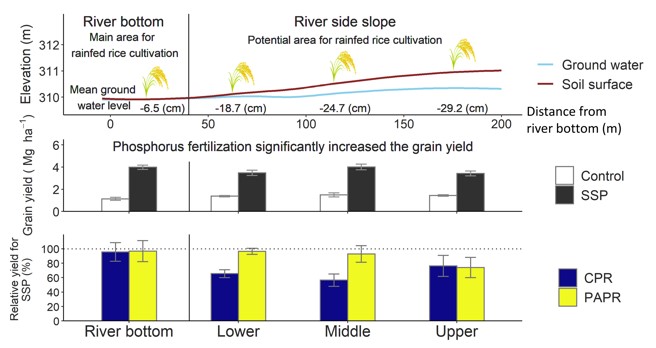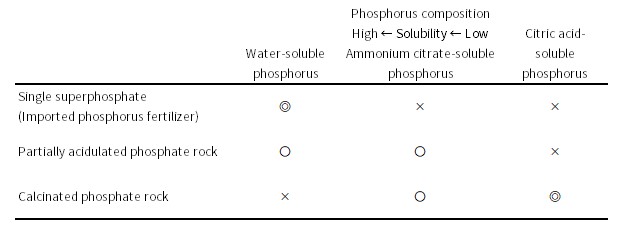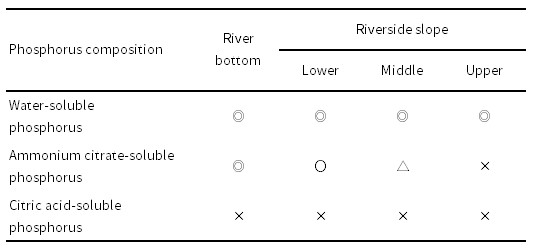African phosphorus fertilizer from indigenous low-grade phosphate rock could replace imported phosphorus fertilizer in rain-fed rice cultivation
Description
In tropical semi-arid regions including Burkina Faso, soils with low phosphorus (P) availability are widely distributed, limiting rainfed rice production. Fertilizer application rates by local farmers are limited mainly due to the high price of imported P fertilizers. A vast amount of phosphate rock deposits are found in Africa. However, most of them have been rarely utilized because of the high impurity and low solubility. If local P fertilizer can be manufactured from this unused resource, it is expected to reduce fertilizer prices and increase fertilizer application rate. Japan International Research Center for Agricultural Science (JIRCAS) has succeeded in increasing the solubility of low-grade African phosphate rock by applying two major methods: partial acidulation and calcination. Imported superphosphate (SSP) mostly consists of water-soluble P (Table 1). On the other hand, partially acidulated phosphate rock (PAPR) consists of water-soluble P and ammonium citrate-soluble P, and calcinated phosphate rock (CPR) of ammonium citrate-soluble P and citric acid-soluble P (Table 1). The solubility is in the order of water-soluble P > ammonium citrate-soluble P > citric acid-soluble P. A field experiment was conducted on the river bottom, which is the main area for rainfed rice cultivation, and on the riverside slope where rainfed rice cultivation can be expanded (Fig. 1, upper panel) to identify the effect of African P fertilizer on rice grain yield.
Rice grain yield is significantly increased by SSP application at all sites on the river bottom and riverside slope (Fig. 1, middle panel), suggesting that P is a limiting factor in rice cultivation. In the river bottom, both partially acidulated and calcined phosphate rock show comparable performance with SSP (Fig. 1, lower panel). Therefore, both can replace imported P fertilizer. In the lower and middle parts of the riverside slope, partially acidulated phosphate rock is as effective as SSP, while calcined phosphate rock is not (Fig. 1, lower panel). Both water-soluble and ammonium citrate-soluble P contributed to grain yield in the river bottom with a high ground-water level, and only water-soluble P contributed to grain yield on the riverside slope with a low ground-water level (Table 2). Therefore, the differences in fertilization effect can be explained by the differences in P composition in fertilizer (Table 1).
Partially acidulated and calcined phosphate rock fertilizers from African low-grade phosphate rock can be widely used in rain-fed rice cultivation in tropical semi-arid regions. Information on effective P fraction in rainfed rice cultivation will be useful for developing the locally adopted P fertilizer.
Figure, table
-
Fig. 1. Outline of the field experiment and fertilization effect of African phosphorus fertilizer from low-grade phosphate rock
Error bar: standard error -
Table 1. Phosphorus composition of fertilizers
◎:> 50%, 〇:25–50%, ×: < 25%
-
Table 2. Contribution of phosphorus fraction to the yield
◎: contributes at 1% level, ○: contributes at 5% level, △: contributes at 10% level
Figure and tables reprinted/modified from Iwasaki et al. (2021) with permission.
- Classification
-
Research
- Research project
- Term of research
-
FY 2019–2021
- Responsible researcher
-
Iwasaki Shinya ( Rural Development Division )
ORCID ID0000-0002-5015-7837KAKEN Researcher No.: 40915261Ikazaki Kenta ( Crop, Livestock and Environment Division )
ORCID ID0000-0001-5460-8570KAKEN Researcher No.: 70582021Nakamura Satoshi ( Crop, Livestock and Environment Division )
ORCID ID0000-0002-0952-5618KAKEN Researcher No.: 00749921Nagumo Fujio ( Crop, Livestock and Environment Division )
KAKEN Researcher No.: 20399372Fukuda Monrawee ( Central Region Agricultural Research Center, NARO )
Ouattara Korodjouma ( Environmental Institute for Agricultural Research, Burkina Faso )
- ほか
- Publication, etc.
-
Iwasaki et al. (2021) Soil Science and Plant Nutirition, 67: 460–470https://doi.org/10.1080/00380768.2021.1932584
- Japanese PDF
-
2021_A10_ja.pdf432.02 KB
- English PDF
-
2021_A10_en.pdf355.36 KB
- Poster PDF
-
2021_A10_poster.pdf309.77 KB
* Affiliation at the time of implementation of the study.



